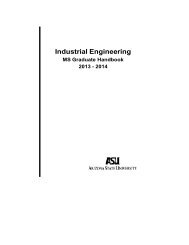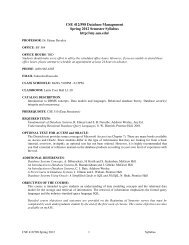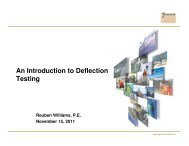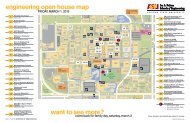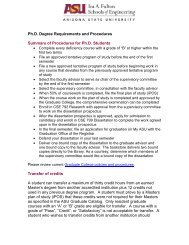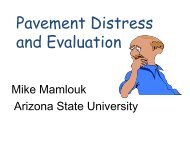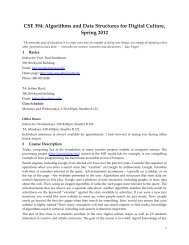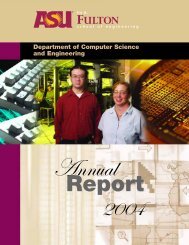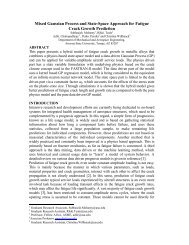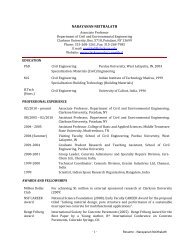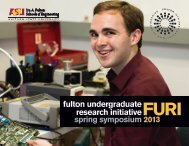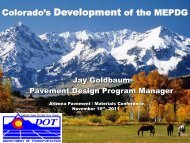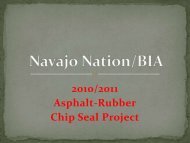Abstract Book - Ira A. Fulton Schools of Engineering - Arizona State ...
Abstract Book - Ira A. Fulton Schools of Engineering - Arizona State ...
Abstract Book - Ira A. Fulton Schools of Engineering - Arizona State ...
Create successful ePaper yourself
Turn your PDF publications into a flip-book with our unique Google optimized e-Paper software.
Development <strong>of</strong> Alginate Based MRI Detectable Microgels<br />
Ameya Jategaonkar, Bioengineering<br />
Graduation: May 2012 Hometown: Rochester, New York<br />
Mentor: Dr. Kevin Bennett, Bioengineering<br />
Grand Challenge: Engineer better medicines<br />
The objective was to develop MRI detectable microgels that report on their structure. Alginic acid was labeled<br />
with cationized ferritin, then crosslinked with Ca2+ ions to develop alginate gel beads. These beads were<br />
placed in solutions with varying concentrations <strong>of</strong> Ca2+. They were analyzed using a Bruker 1.5 T relaxometer.<br />
When the beads were placed in solutions with low Ca2+ concentrations, they swelled. This was reported by the<br />
relaxometer as roughly a 34% increase in T2 relaxation. Electrospraying reduced the bead diameter to a few<br />
hundred microns. Emuslion techniques can be explored to further reduce the diameter <strong>of</strong> the beads.<br />
Identification and Quantification <strong>of</strong> Fatty-Acid Consuming Bacteria in<br />
Synechocystis sp. PCC 6803 -Based Photobioreactors Using Bacterial 16S<br />
rDNA and Selective Plating<br />
Galen Toby Johnson-Bates, Chemical <strong>Engineering</strong><br />
Graduation: May 2012 Hometown: Scottsdale, <strong>Arizona</strong><br />
Mentor: Dr. Rosa Krajmalnik-Brown, Civil and Environmental <strong>Engineering</strong><br />
Grand Challenge: Develop carbon sequestration methods<br />
The objective was to identify and quantify bacteria in Synechocystis sp. based photobioreactors using<br />
bacterial 16S rDNA fingerprinting methods. DNA from culture samples containing Synechocystis, among other<br />
microorganisms, underwent PCR amplification and T-RFLP analysis to monitor shifts in microbial ecology over<br />
time. Also, a plating assay was developed to quickly detect fatty acid scavengers using free fatty acids as<br />
sole carbon and energy source. Conclusively, photobioreactor cultures consist mostly <strong>of</strong> Synechocystis while<br />
in “healthy” state, and diversify significantly when the culture’s health is compromised. Future research should<br />
include additional analysis <strong>of</strong> community DNA and optimization <strong>of</strong> the plating assay.<br />
Hyperthermic Ablation <strong>of</strong> Cancer Cells Using Gold Nanorods<br />
David Kay, Bioengineering<br />
Graduation: May 2010 Hometown: Tucson, <strong>Arizona</strong><br />
Mentor: Dr. Kaushal Rege, Chemical <strong>Engineering</strong><br />
Grand Challenge: Engineer better medicines<br />
Previous work in this project has involved applying laser to thermally ablate cancer cells treated with polymercoated<br />
gold nanorods (GNRs). The objective <strong>of</strong> this semester’s work has been to continue using circular<br />
dichroism to demonstrate the denaturing <strong>of</strong> proteins responsible for this cell death following induced<br />
hyperthermia. This has been done by gathering the initial ellipticity curves <strong>of</strong> proteins, and comparing these<br />
curves to proteins that have been heated using GNRs and laser application. Thus far, bovine serum albumin,<br />
lysozyme and lactalbumin have been investigated, and future work will involve calmodulin.<br />
Spring 2010 19



